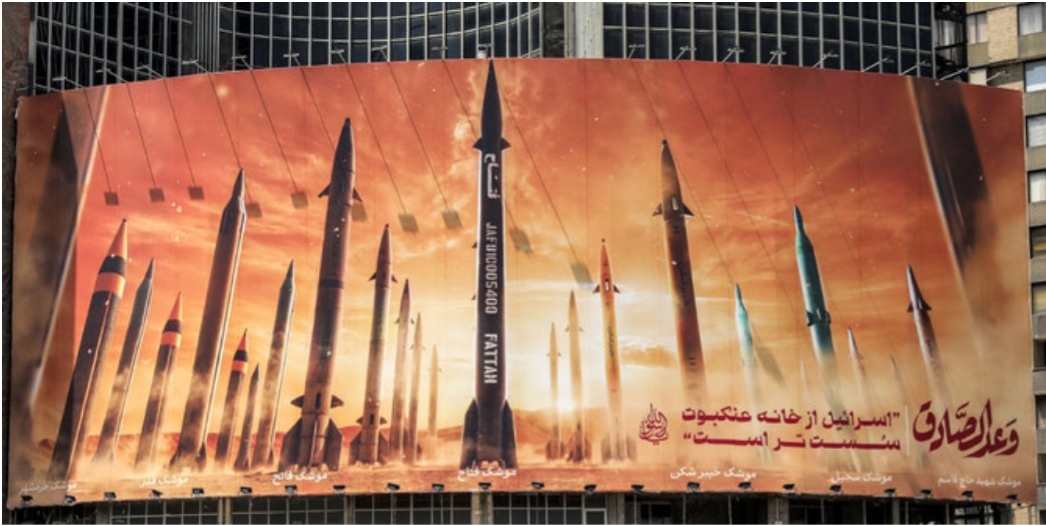You think this situation is terrifying? Wait until Iran goes nuclear

Billboard in central Tehran depicting named Iranian ballistic missiles in service
While the tit-for-tat exchange between Israel and Iran has fundamentally altered strategic calculations about regional security, it is just starting to dawn on the world how much more dangerous the situation would be if both sides possessed nuclear weapons.
Israel’s strike at Isfahan, in the vicinity of several nuclear facilities, was a warning shot, while Revolutionary Guards commander Ahmad Haqtalab threatened to attack Israeli nuclear sites if Iranian installations were targeted. Haqtalab warned of Iran’s readiness to revise its doctrine on developing its own nuclear weapons, fueling concerns that Tehran could embark on a final rush toward acquiring these capabilities.
International Atomic Energy Agency inspectors report “frenzied activity” at Iran’s Fordow nuclear site, including newly installed equipment, enrichment of uranium with ever greater rapidity and expansion projects for doubling the plant’s output and scaling up of uranium production just a “flip of a switch” from weapons grade. Iran’s larger Natanz plant is also vigorously churning out highly enriched uranium. Iran is building additional infrastructure so deep into the Natanz mountainside that there are doubts that any kind of US or Israeli strike could touch nuclear activities there.
Experts warn that Iran requires just a few days to upgrade sufficient uranium for three bombs. Manufacture of a crude nuclear device would take about six months, while building a missile-delivered nuclear warhead may require a couple of years, assuming Tehran has not clandestinely developed these capabilities already. Documents stolen in a 2018 Israeli raid indicate years of extensive research into the full spectrum of capabilities necessary for engineering nuclear Armageddon.
Iran’s top nuclear official, Mohammed Eslami, appeared to boast in January that Iran had arrived at military breakout threshold, crowing that “deterrence has been achieved.” IAEA director general Rafael Grossi condemned this “loose talk” about possessing nuclear weapons, while warning of a domino effect as other regional states raced to acquire their own nuclear capacities.
There are numerous terrifying scenarios that could rapidly escalate into a nuclear exchange, leaving millions dead and the region destroyed
Baria Alamuddin
I recall participating in the 2009 Doha Debate, arguing against those making the case that Iran could be trusted not to build a nuclear bomb. Iran’s apologists, including supposed experts and academics, took the view that Ayatollah Ali Khamenei had declared nuclear weapons to be un-Islamic, while asserting a God-given right to enrich uranium. I argued the case for a region wholly free of weapons of mass destruction, although I would go further in advocating comprehensive global nuclear disarmament. Since 2022, this existential threat has been further highlighted by the casual manner in which Russia has repeatedly expressed its readiness to resort to these horrific weapons whenever it came under pressure over Ukraine.
The mutual embrace between the likes of China, Iran, Russia and North Korea is growing ever tighter. Despite the latest batches of sanctions imposed on Tehran, we have arguably entered an era in which Western sanctions are broadly irrelevant. This large bloc of states, containing a sizable proportion of the planet’s population, is able to trade, finance itself, arm itself and secure its energy needs, while Western leaders impotently yell and decry from the sidelines, in a world in which the dollar no longer holds universal sway. The same processes have utterly paralyzed the global infrastructure for international law and conflict resolution established after the Second World War. So, does the regime in Tehran feel increasingly untouchable? Damn right it does.
Over recent months, proxies such as Hezbollah have nervously pulled their punches to avoid disproportionate retaliation from a greatly superior Israeli fighting machine. But what about a scenario in which Hezbollah and other paramilitaries fired tens of thousands of missiles at Israeli population centers, while Tehran pointed its nukes at Tel Aviv and dared Israel to respond? Given that Israel already has its own nuclear arsenal, there are numerous terrifying scenarios that could rapidly escalate into a nuclear exchange, leaving millions dead and the region destroyed.
For many years, posturing world leaders declared that Iran would not be allowed to continue enriching uranium to 5 percent purity. Then it was 20 percent. Now the nuclear clock is ticking inexorably toward midnight. Will it be another North Korea, when rhetoric about not allowing Pyongyang to develop advanced military capacities was supplanted by language about learning to live with a nuclearized Korean Peninsula and hoping for the best?
Although Barack Obama’s 2015 nuclear deal was deeply flawed, Donald Trump’s unilateral withdrawal in 2018 and the imposition of largely ineffective sanctions was disastrous, allowing Tehran to continue its progress toward a bomb. Biden administration officials have long since acknowledged that efforts to revive the 2015 deal are dead in the water, but their failure to consider other options has left a dangerous policy vacuum. Iran’s rejection of key elements of IAEA inspections means the watchdog may be incapable of detecting nuclear breakout. As one US official put it, the Iranians are “dancing right up to the edge.”
The horrors of nuclear conflict are, by definition, unthinkable, meaning mediocre Western leaders have consistently refused to think seriously about these increasingly imminent threats or countenance strategic policies that could halt this menace.
Twenty years of nuclear negotiations produced precisely nothing, other than marginally delaying Tehran’s nuclear ambitions. The current escalatory regional situation is terrifying — but it is not a fraction as bad as it could be once the atomic ambitions of the ayatollahs are realized, while Israel’s blood-drunk leaders continue to push threat levels beyond boiling point, driving the planet inexorably closer to the real risk of nuclear apocalypse.




